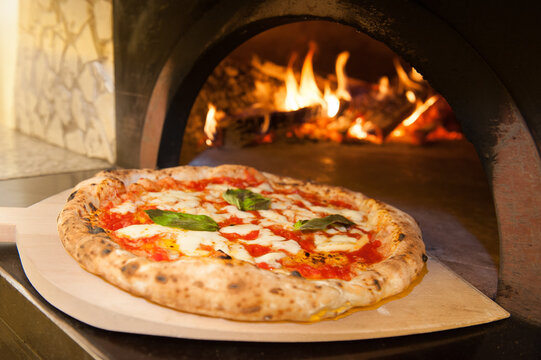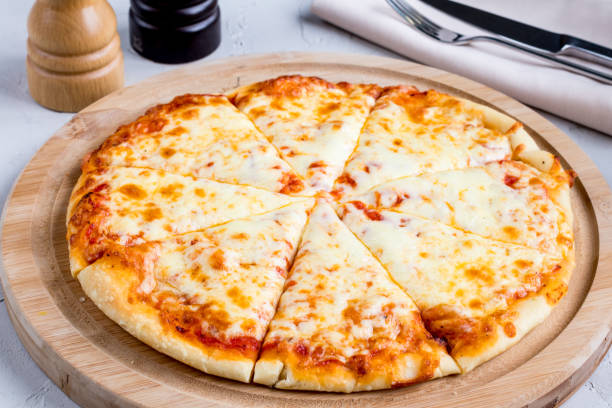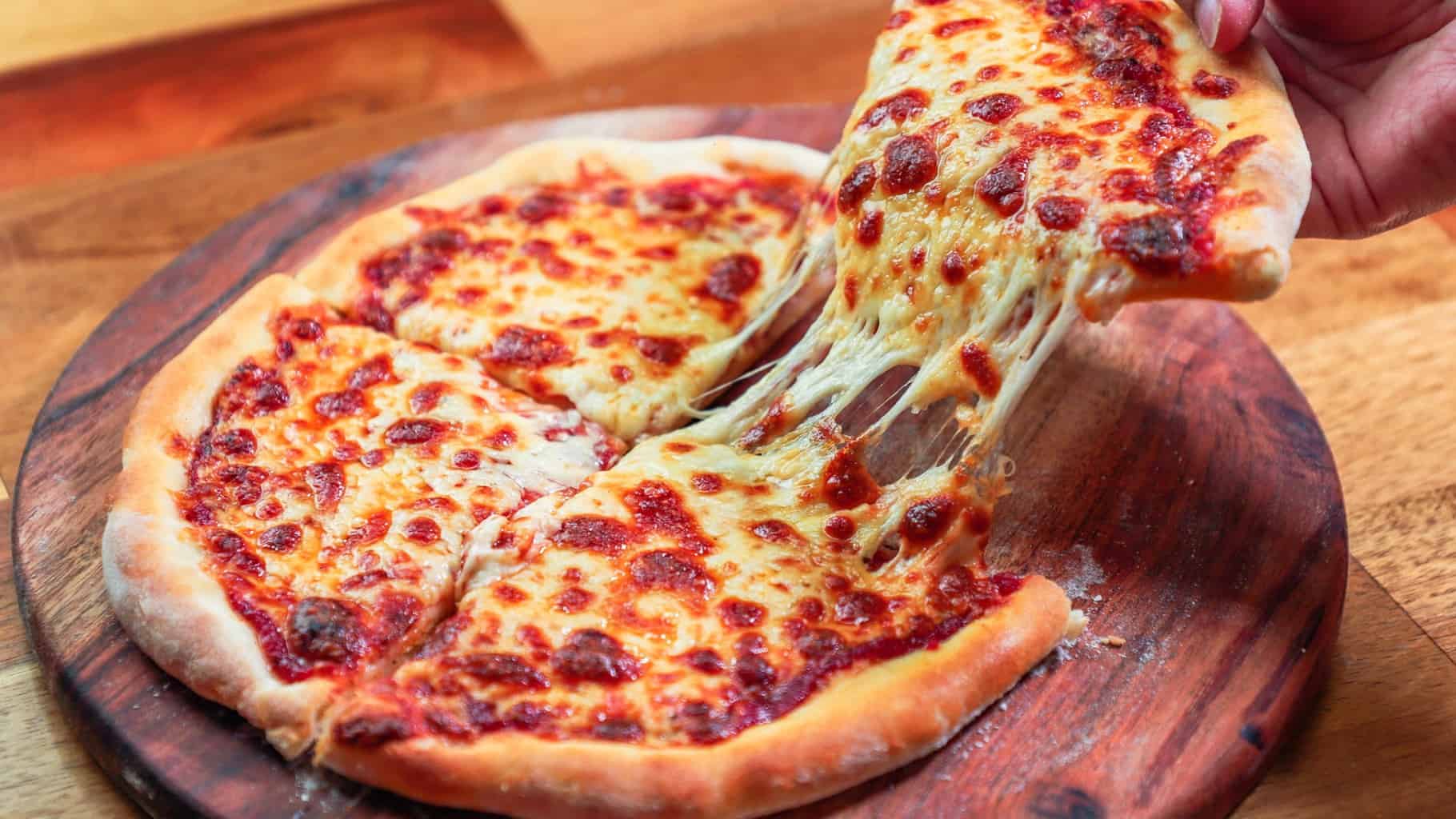Margherita pizza has become a symbol in the world of Italian food, beloved by people all over the world. This traditional Neapolitan dish has become a menu mainstay all over the globe because to its delicate yet flavorful blend of fresh ingredients. However, behind its immense appeal is a culinary heritage and a history that captures the spirit of Italian cuisine.
A Slice of History: Origins of Margherita Pizza:
Margherita pizza originated in Naples, Italy in the latter part of the nineteenth century. In 1889, when Queen Margherita of Savoy and King Umberto I were in town, famed pizzaiolo (pizza maker) Raffaele Esposito supposedly had the distinction of making a special pizza to celebrate their visit. Pizza maker Esposito used cues from the Italian flag’s tricolor—red for tomatoes, white for mozzarella, and green for basil—when designing his dish. Not only did it satisfy the royal palate, but it also perfectly embodied Italy’s rich culinary history.

The Perfect Harmony: Ingredients and Preparation:
Margherita pizza, at its heart, is an embodiment of the freshness and simplicity that characterize Italian cuisine. Neapolitan pizza dough, a foundation of which is hand-stretched to attain the ideal thin crust, is traditionally made using a careful combination of flour, water, yeast, and salt. Then, to make a sweet and tart base, crush some San Marzano tomatoes and scatter them evenly over the dough. Their brilliant red color will do the trick.
What makes a Margherita pizza special, though, is the layer of fresh mozzarella cheese on top. This soft, luscious cheese, made from the milk of cows or water buffalo, goes wonderfully with the other flavors and textures. The pizza wouldn’t be the same without the delicious mozzarella, which is perfect whether sliced or broken into rustic chunks.
The last touch, the pièce de résistance: a scattering of fresh basil leaves atop the pizza before it goes into the searing heat of a wood-fired oven. In addition to imparting its fragrant essence to the pizza, basil adds a burst of herbal freshness that complements the other flavors.
:max_bytes(150000):strip_icc()/mozzarella-pizza-margherita-FT-RECIPE0621-11fa41ceb1a5465d9036a23da87dd3d4.jpg)
Savoring the Experience: Margherita Pizza Around the World:
Everyone loves Margherita pizza, even though it was born in Naples. This legendary dish has become a worldwide culinary phenomenon, appearing in everything from crowded New York City pizzerias to charming Tokyo trattorias. There is a long history of skill and tradition that goes into making the best pizza, and it shows in every mouthful.
Organizations like the Associazione Verace Pizza Napoletana (AVPN) are doing their best to keep traditional pizza-making methods alive and well, thanks to the renewed interest in real Neapolitan pizza in recent years. Thanks to these efforts, Margherita pizza may be savored as it is, capturing the essence of Italy’s culinary legacy in every mouthful.

Recipe for making Margherita pizza at home:
Ingredients:
For the pizza dough:
- 2 1/4 cups (280g) all-purpose flour
- 1 teaspoon active dry yeast
- 1 teaspoon sugar
- 3/4 cup (180ml) warm water
- 1 tablespoon olive oil
- 1/2 teaspoon salt
For the toppings:
- 1/2 cup (120ml) tomato sauce or passata
- 8 ounces (225g) fresh mozzarella cheese, sliced or torn into pieces
- Fresh basil leaves
- Extra virgin olive oil, for drizzling
- Salt and freshly ground black pepper, to taste
Instructions:
1. Prepare the Pizza Dough:
- In a small bowl, combine the warm water, sugar, and yeast. Let it sit for about 5-10 minutes until foamy.
- In a large mixing bowl, combine the flour and salt. Make a well in the center and pour in the yeast mixture and olive oil.
- Stir the ingredients until a dough forms. Turn the dough out onto a floured surface and knead for about 5-7 minutes until smooth and elastic.
- Place the dough in a lightly oiled bowl, cover with a clean kitchen towel, and let it rise in a warm place for about 1-2 hours, or until doubled in size.
2. Preheat the Oven:
- Preheat your oven to the highest temperature it can go, usually around 500°F (260°C) or higher. If you have a pizza stone, place it in the oven to preheat as well.
3. Shape the Dough:
- Once the dough has risen, punch it down and divide it into two equal portions for thin-crust pizzas or leave it whole for a thicker crust.
- On a floured surface, roll out the dough into your desired pizza shape – round, oval, or rectangular – about 1/4 inch thick.
4. Assemble the Pizza:
- Place the rolled-out dough on a lightly floured pizza peel or baking sheet.
- Spread a thin layer of tomato sauce over the dough, leaving a small border around the edges.
- Arrange the mozzarella cheese slices or torn pieces evenly over the sauce.
- Tear the fresh basil leaves and scatter them over the cheese.
- Drizzle a little extra virgin olive oil over the pizza and season with salt and freshly ground black pepper to taste.
5. Bake the Pizza:
- Carefully transfer the assembled pizza to the preheated oven, either directly onto the pizza stone or onto a baking sheet.
- Bake for 10-12 minutes, or until the crust is golden brown and the cheese is bubbling and slightly browned.
6. Serve:
- Once baked, remove the pizza from the oven and let it cool for a minute or two before slicing.
- Garnish with additional fresh basil leaves if desired.
- Serve hot and enjoy your homemade Margherita pizza!
Tips:
- For an extra crispy crust, preheat your baking sheet or pizza stone in the oven before placing the pizza on it.
- Feel free to customize your Margherita pizza with additional toppings like sliced tomatoes, garlic, or a sprinkle of Parmesan cheese, but remember to keep it simple to let the flavors of the classic Margherita shine through.

Facts about Margherita pizza:
Royal Origins:
It is said that Neapolitan pizzaiolo Raffaele Esposito made the Margherita pizza in 1889 for Queen Margherita of Savoy when she visited Naples, Italy. As a nod to the Italian flag, we topped our pizza with tomatoes, mozzarella, and basil.
Symbol of Italian Unity:
Because Italy had only just recently become a nation in 1861, the choice of Margherita pizza as a tribute to Queen Margherita was also a symbolic act of national unification.
Protected Traditional Specialty:
Margherita and other Neapolitan pizzas were awarded Traditional Specialty Guaranteed (TSG) designation by the European Union in 2009. Pizzas that use the term “Neapolitan” are guaranteed to use only traditional recipes and ingredients.
AVPN Certification:
Established in 1984 in Naples, the Associazione Verace Pizza Napolitano (True Neapolitan Pizza Association) seeks to preserve and spread the authentic Neapolitan pizza culture. Pizza places all over the world that adhere to their rigorous ingredient, preparation, and cooking process standards are certified by them.
Simple Ingredients, Rich Flavor:
The classic Margherita pizza uses only a handful of high-quality ingredients—fresh San Marzano tomatoes, mozzarella cheese (usually made from buffalo milk), basil, olive oil, salt, and occasionally Parmesan cheese—and is known for its simplicity. The flavors are able to really pop because to this spare presentation.
Wood-Fired Oven:
High temperatures, usually around 800°F (427°C), are required to cook traditional Margherita pizzas in a wood-fired oven. In about 60 to 90 seconds, you may get a crust that is blistered and charred while the toppings stay fresh and colorful.
Worldwide Popularity:
Although Margherita pizza has its roots in Naples, it has since become a beloved dish among pizza enthusiasts around the world. With its innumerable modifications and adaptations, it has become a menu staple in pizzerias all over the globe.
Cultural Influence:
Margherita pizza has made an impression on popular culture through its appearances in movies, books, and artwork. Pizza is a universally beloved dish, and many festivals and competitions honor it as a culinary icon of Italy.
Versatile and Adaptable:
Although traditional Margherita pizza calls for certain ingredients, it’s really quite flexible. Both professional and amateur cooks frequently play around with the original recipe’s flavors by adding new sauces, cheeses, and toppings.
Timeless Appeal:
Margherita pizza has stood the test of time, even as pizza trends come and go. For pizza lovers of all ages, it’s the perfect blend of cultural relevance, rich history, and vivid, fresh ingredients.

FAQs about Margherita pizza:
Q. What is Margherita pizza?
- The traditional Margherita pizza is made with a thin crust, tomato sauce, mozzarella cheese, basil leaves, olive oil, and occasionally salt and pepper. It is a classic Neapolitan style pizza.
Q. Why is it called Margherita pizza?
- The 1889 visit of Queen Margherita of Savoy to Naples is the inspiration for the Margherita pizza moniker. The pizza was supposedly made in her honor, with the three colors of the Italian flag—red for tomatoes, white for mozzarella, and green for basil—representing the toppings.
Q. What are the traditional ingredients of Margherita pizza?
- Margherita pizza sauce is traditionally made with San Marzano tomatoes, mozzarella cheese (ideally buffalo milk), fresh basil leaves, extra virgin olive oil, salt, and occasionally Parmesan cheese.
Q. What makes a Margherita pizza authentic?
- The Associazione Verace Pizza Napoletana (AVPN) and similar groups have established criteria that must be met by any pizza claiming to be Margherita. Certain ingredients, like as buffalo mozzarella and San Marzano tomatoes, are used, along with hand-stretching the dough and high-temperature cooking in a wood-fired oven.
Q. Can I use regular mozzarella cheese instead of buffalo mozzarella?
- Margherita pizza is traditionally made using buffalo mozzarella, which lends a distinctive flavor and texture, but you may also use conventional cow’s milk mozzarella. Ensure that it is both fresh and not excessively watery.
Q. Do I have to use fresh basil leaves, or can I use dried basil?
- Margherita pizza is best made using fresh basil leaves since they add more taste and fragrance than dried basil. You can use dried basil sparingly in place of fresh basil if that is not an option.
Q. Can I add additional toppings to my Margherita pizza?
- Feel free to try different combinations of toppings if you desire; purists might say that doing so changes the recipe from a traditional Margherita pizza. Remember that less is more, and that the delicate flavor balance can be overwhelmed by an excess of toppings.
Q. How do I reheat leftover Margherita pizza?
- Preheating the oven to 375°F (190°C) will allow any leftover Margherita pizza to be heated through. Just lay the slices out on a baking sheet and bake for 8-10 minutes, or until done. On the other hand, you can warm up a few slices in a skillet over medium heat.
Q. Is Margherita pizza vegetarian?
- There is no meat or animal components on a Margherita pizza, thus it is definitely vegetarian. It’s a favorite among both pizza lovers and vegetarians.
Q. Can I make Margherita pizza gluten-free?
- If you use a gluten-free pizza dough or crust mix, you can absolutely bake Margherita pizza without gluten. Verify that the tomato sauce, cheese, and all other components are free of gluten.
Conclusion: A Taste of Tradition:
Margherita pizza is a constant reminder of the best of Italian cuisine in a world where fads come and go. Because of its simplicity, freshness, and capacity to take customers on a gustatory adventure to the streets of Naples, it has an enduring allure. Margherita pizza, whether eaten in a busy pizzeria or at home, is a tasty symbol of the strength of tradition and the delight of appreciating the little things in life, slice after slice.
THANKS FOR READING
READ MORE :- The Enchanting Allure of Cacio e Pepe Egg Noodles: A Delicate Romance
